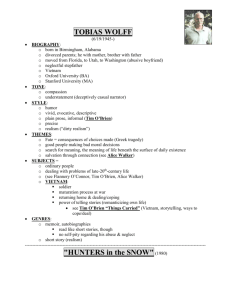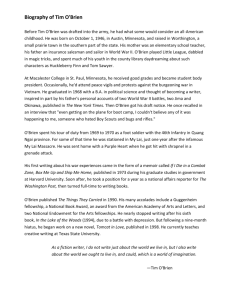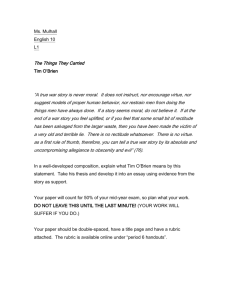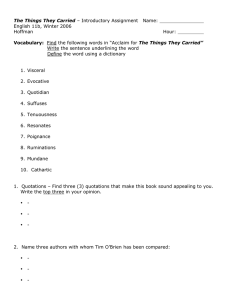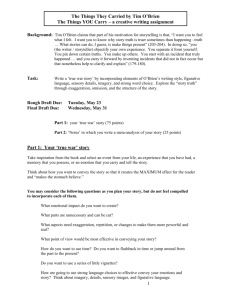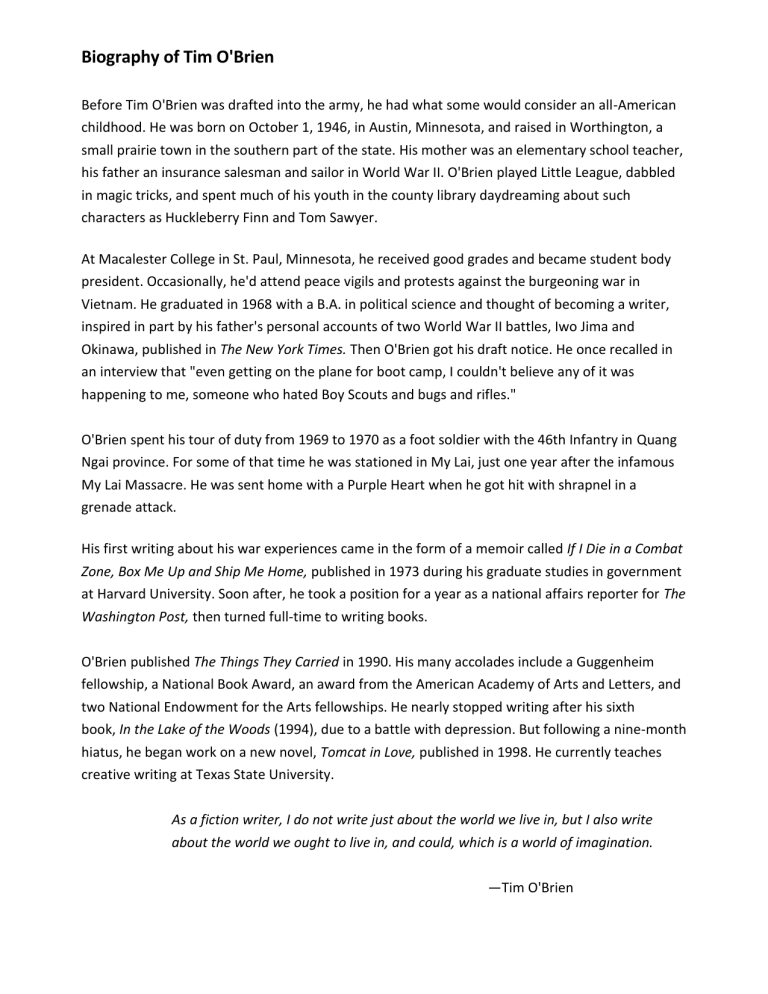
Biography of Tim O'Brien Before Tim O'Brien was drafted into the army, he had what some would consider an all-American childhood. He was born on October 1, 1946, in Austin, Minnesota, and raised in Worthington, a small prairie town in the southern part of the state. His mother was an elementary school teacher, his father an insurance salesman and sailor in World War II. O'Brien played Little League, dabbled in magic tricks, and spent much of his youth in the county library daydreaming about such characters as Huckleberry Finn and Tom Sawyer. At Macalester College in St. Paul, Minnesota, he received good grades and became student body president. Occasionally, he'd attend peace vigils and protests against the burgeoning war in Vietnam. He graduated in 1968 with a B.A. in political science and thought of becoming a writer, inspired in part by his father's personal accounts of two World War II battles, Iwo Jima and Okinawa, published in The New York Times. Then O'Brien got his draft notice. He once recalled in an interview that "even getting on the plane for boot camp, I couldn't believe any of it was happening to me, someone who hated Boy Scouts and bugs and rifles." O'Brien spent his tour of duty from 1969 to 1970 as a foot soldier with the 46th Infantry in Quang Ngai province. For some of that time he was stationed in My Lai, just one year after the infamous My Lai Massacre. He was sent home with a Purple Heart when he got hit with shrapnel in a grenade attack. His first writing about his war experiences came in the form of a memoir called If I Die in a Combat Zone, Box Me Up and Ship Me Home, published in 1973 during his graduate studies in government at Harvard University. Soon after, he took a position for a year as a national affairs reporter for The Washington Post, then turned full-time to writing books. O'Brien published The Things They Carried in 1990. His many accolades include a Guggenheim fellowship, a National Book Award, an award from the American Academy of Arts and Letters, and two National Endowment for the Arts fellowships. He nearly stopped writing after his sixth book, In the Lake of the Woods (1994), due to a battle with depression. But following a nine-month hiatus, he began work on a new novel, Tomcat in Love, published in 1998. He currently teaches creative writing at Texas State University. As a fiction writer, I do not write just about the world we live in, but I also write about the world we ought to live in, and could, which is a world of imagination. —Tim O'Brien en.wikipedia.org www.statesman.com cds.library.brown.edu An Interview with Tim O'Brien On November 13, 2008, Josephine Reed, Managing Audio Producer at the National Endowment for the Arts, interviewed Tim O'Brien. Excerpts from their conversation follow. Josephine Reed: What is The Things They Carried about? Tim O'Brien: It's a book that centers on Vietnam and a platoon of soldiers. In one sense, it's about the Vietnam War, but it's also about storytelling, how stories rule our lives, how they're told and retold as we look for an elusive truth. And finally, it's about writing itself—writing as an effort to pin down with language the truth about a subject. JR: What is the distinction between truth and accuracy? TO: What we see accurately with our eyes can sometimes be very deceptive. We don't see everything. No historian can fit into a textbook the thoughts of every single soldier in every single war and every single episode. Much is being selected and generalized. So in The Things They Carried, I'm trying to get at this sense of how difficult it is to pin down the truth with a capital "T." In a way, it's a warning against absolutism, against black and white declarations of what's true and what's not true. So part of the effort is trying to display through fiction the ambiguous, blurry, complicated, grayish fog of even the most plainly historical events. JR: I was profoundly moved by the story "On the Rainy River," not only by the character of Tim, but also the old man, Elroy. He seemed as real to me as the man sitting next to me on the train this morning. TO: That's an example of what imagination can do. He's an imagined character—more so, even, than the Tim O'Brien character, who is also, I must say, imagined. But the old guy is made up out of the whole cloth. And yet, he represents something real that you couldn't put your finger on, which has to do with conscience, or being watched by, say, a dead father—that feeling of someone there with you who's not offering advice but is simply present as a kind of moral witness. Old Elroy is meant to stand for a whole bunch of things: my dad, my mom, my country, God, and conscience, all together. JR: I'd also like to talk about your story "Sweetheart of the Song Tra Bong." It reminded me very much of Heart of Darkness. TO: Yes, it was intentionally structured to be the other hemisphere of Heart of Darkness. Because Kurtz is a man, because Marlow's a man, and because virtually every character in the story is a man, the whole structure of my story is meant to be a female flip of it. In a way, I was trying to put a woman in a man's boots and see if she behaves much differently or feels other things than a man might feel. In a way the point of the story (if stories ever have "points"—and of course they don't, or maybe they have a trillion angles on a point) has to do with the image of the woman as nurturer and peaceful and incapable of the conspicuously violent behaviors of men—which, of course, when you look at history, is totally ridiculous. So the story is meant to be inclusive of women in almost all war stories. JR: You structured this book in such an interesting way. Each individual story is like a small gem, like a pearl necklace. But when you string them together, the cumulative effect is powerful. TO: That's my goal. I wanted to have self-contained stories that I think all chapters of books ought to be anyway. Yet I wanted each story to receive the light of other stories, the way it would in a necklace. Or one gemstone would receive the light of the ruby next to it. Although they are meant to stand alone, it seems to me that in the end, you aim ambitiously for what all writers worth their salt aim at—of making a book of art, of some sort. And that's the sense of pieces being in position, so that they can reflect. So that the pieces are capable of not just reflecting, but absorbing the light of the others. Work Cited "The Big Read." The Big Read: The Things They Carried. National Endowment for the Arts, n.d. Web. 01 Apr. 2014. <http://www.neabigread.org/books/thethingstheycarried/readersguide/about-the-author/>.
